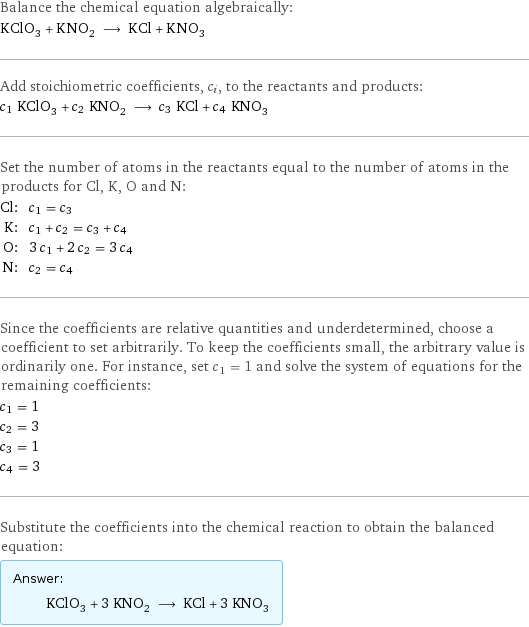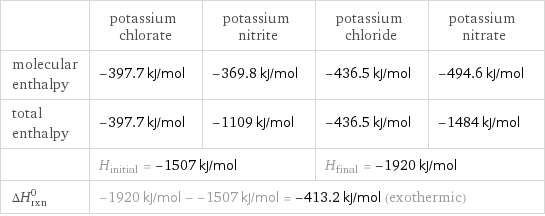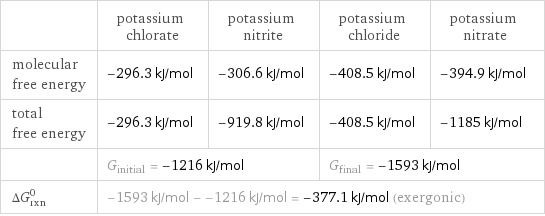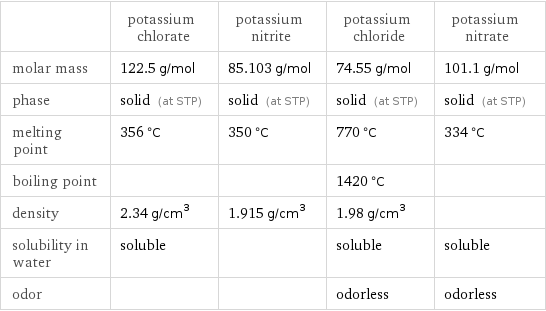Input interpretation

KClO_3 (potassium chlorate) + KNO_2 (potassium nitrite) ⟶ KCl (potassium chloride) + KNO_3 (potassium nitrate)
Balanced equation

Balance the chemical equation algebraically: KClO_3 + KNO_2 ⟶ KCl + KNO_3 Add stoichiometric coefficients, c_i, to the reactants and products: c_1 KClO_3 + c_2 KNO_2 ⟶ c_3 KCl + c_4 KNO_3 Set the number of atoms in the reactants equal to the number of atoms in the products for Cl, K, O and N: Cl: | c_1 = c_3 K: | c_1 + c_2 = c_3 + c_4 O: | 3 c_1 + 2 c_2 = 3 c_4 N: | c_2 = c_4 Since the coefficients are relative quantities and underdetermined, choose a coefficient to set arbitrarily. To keep the coefficients small, the arbitrary value is ordinarily one. For instance, set c_1 = 1 and solve the system of equations for the remaining coefficients: c_1 = 1 c_2 = 3 c_3 = 1 c_4 = 3 Substitute the coefficients into the chemical reaction to obtain the balanced equation: Answer: | | KClO_3 + 3 KNO_2 ⟶ KCl + 3 KNO_3
Structures

+ ⟶ +
Names

potassium chlorate + potassium nitrite ⟶ potassium chloride + potassium nitrate
Reaction thermodynamics
Enthalpy

| potassium chlorate | potassium nitrite | potassium chloride | potassium nitrate molecular enthalpy | -397.7 kJ/mol | -369.8 kJ/mol | -436.5 kJ/mol | -494.6 kJ/mol total enthalpy | -397.7 kJ/mol | -1109 kJ/mol | -436.5 kJ/mol | -1484 kJ/mol | H_initial = -1507 kJ/mol | | H_final = -1920 kJ/mol | ΔH_rxn^0 | -1920 kJ/mol - -1507 kJ/mol = -413.2 kJ/mol (exothermic) | | |
Gibbs free energy

| potassium chlorate | potassium nitrite | potassium chloride | potassium nitrate molecular free energy | -296.3 kJ/mol | -306.6 kJ/mol | -408.5 kJ/mol | -394.9 kJ/mol total free energy | -296.3 kJ/mol | -919.8 kJ/mol | -408.5 kJ/mol | -1185 kJ/mol | G_initial = -1216 kJ/mol | | G_final = -1593 kJ/mol | ΔG_rxn^0 | -1593 kJ/mol - -1216 kJ/mol = -377.1 kJ/mol (exergonic) | | |
Equilibrium constant
![Construct the equilibrium constant, K, expression for: KClO_3 + KNO_2 ⟶ KCl + KNO_3 Plan: • Balance the chemical equation. • Determine the stoichiometric numbers. • Assemble the activity expression for each chemical species. • Use the activity expressions to build the equilibrium constant expression. Write the balanced chemical equation: KClO_3 + 3 KNO_2 ⟶ KCl + 3 KNO_3 Assign stoichiometric numbers, ν_i, using the stoichiometric coefficients, c_i, from the balanced chemical equation in the following manner: ν_i = -c_i for reactants and ν_i = c_i for products: chemical species | c_i | ν_i KClO_3 | 1 | -1 KNO_2 | 3 | -3 KCl | 1 | 1 KNO_3 | 3 | 3 Assemble the activity expressions accounting for the state of matter and ν_i: chemical species | c_i | ν_i | activity expression KClO_3 | 1 | -1 | ([KClO3])^(-1) KNO_2 | 3 | -3 | ([KNO2])^(-3) KCl | 1 | 1 | [KCl] KNO_3 | 3 | 3 | ([KNO3])^3 The equilibrium constant symbol in the concentration basis is: K_c Mulitply the activity expressions to arrive at the K_c expression: Answer: | | K_c = ([KClO3])^(-1) ([KNO2])^(-3) [KCl] ([KNO3])^3 = ([KCl] ([KNO3])^3)/([KClO3] ([KNO2])^3)](../image_source/9b2aa33f6d34a39618ba3332ef7f1080.png)
Construct the equilibrium constant, K, expression for: KClO_3 + KNO_2 ⟶ KCl + KNO_3 Plan: • Balance the chemical equation. • Determine the stoichiometric numbers. • Assemble the activity expression for each chemical species. • Use the activity expressions to build the equilibrium constant expression. Write the balanced chemical equation: KClO_3 + 3 KNO_2 ⟶ KCl + 3 KNO_3 Assign stoichiometric numbers, ν_i, using the stoichiometric coefficients, c_i, from the balanced chemical equation in the following manner: ν_i = -c_i for reactants and ν_i = c_i for products: chemical species | c_i | ν_i KClO_3 | 1 | -1 KNO_2 | 3 | -3 KCl | 1 | 1 KNO_3 | 3 | 3 Assemble the activity expressions accounting for the state of matter and ν_i: chemical species | c_i | ν_i | activity expression KClO_3 | 1 | -1 | ([KClO3])^(-1) KNO_2 | 3 | -3 | ([KNO2])^(-3) KCl | 1 | 1 | [KCl] KNO_3 | 3 | 3 | ([KNO3])^3 The equilibrium constant symbol in the concentration basis is: K_c Mulitply the activity expressions to arrive at the K_c expression: Answer: | | K_c = ([KClO3])^(-1) ([KNO2])^(-3) [KCl] ([KNO3])^3 = ([KCl] ([KNO3])^3)/([KClO3] ([KNO2])^3)
Rate of reaction
![Construct the rate of reaction expression for: KClO_3 + KNO_2 ⟶ KCl + KNO_3 Plan: • Balance the chemical equation. • Determine the stoichiometric numbers. • Assemble the rate term for each chemical species. • Write the rate of reaction expression. Write the balanced chemical equation: KClO_3 + 3 KNO_2 ⟶ KCl + 3 KNO_3 Assign stoichiometric numbers, ν_i, using the stoichiometric coefficients, c_i, from the balanced chemical equation in the following manner: ν_i = -c_i for reactants and ν_i = c_i for products: chemical species | c_i | ν_i KClO_3 | 1 | -1 KNO_2 | 3 | -3 KCl | 1 | 1 KNO_3 | 3 | 3 The rate term for each chemical species, B_i, is 1/ν_i(Δ[B_i])/(Δt) where [B_i] is the amount concentration and t is time: chemical species | c_i | ν_i | rate term KClO_3 | 1 | -1 | -(Δ[KClO3])/(Δt) KNO_2 | 3 | -3 | -1/3 (Δ[KNO2])/(Δt) KCl | 1 | 1 | (Δ[KCl])/(Δt) KNO_3 | 3 | 3 | 1/3 (Δ[KNO3])/(Δt) (for infinitesimal rate of change, replace Δ with d) Set the rate terms equal to each other to arrive at the rate expression: Answer: | | rate = -(Δ[KClO3])/(Δt) = -1/3 (Δ[KNO2])/(Δt) = (Δ[KCl])/(Δt) = 1/3 (Δ[KNO3])/(Δt) (assuming constant volume and no accumulation of intermediates or side products)](../image_source/96f410ee7458845f90b984499ee72ecb.png)
Construct the rate of reaction expression for: KClO_3 + KNO_2 ⟶ KCl + KNO_3 Plan: • Balance the chemical equation. • Determine the stoichiometric numbers. • Assemble the rate term for each chemical species. • Write the rate of reaction expression. Write the balanced chemical equation: KClO_3 + 3 KNO_2 ⟶ KCl + 3 KNO_3 Assign stoichiometric numbers, ν_i, using the stoichiometric coefficients, c_i, from the balanced chemical equation in the following manner: ν_i = -c_i for reactants and ν_i = c_i for products: chemical species | c_i | ν_i KClO_3 | 1 | -1 KNO_2 | 3 | -3 KCl | 1 | 1 KNO_3 | 3 | 3 The rate term for each chemical species, B_i, is 1/ν_i(Δ[B_i])/(Δt) where [B_i] is the amount concentration and t is time: chemical species | c_i | ν_i | rate term KClO_3 | 1 | -1 | -(Δ[KClO3])/(Δt) KNO_2 | 3 | -3 | -1/3 (Δ[KNO2])/(Δt) KCl | 1 | 1 | (Δ[KCl])/(Δt) KNO_3 | 3 | 3 | 1/3 (Δ[KNO3])/(Δt) (for infinitesimal rate of change, replace Δ with d) Set the rate terms equal to each other to arrive at the rate expression: Answer: | | rate = -(Δ[KClO3])/(Δt) = -1/3 (Δ[KNO2])/(Δt) = (Δ[KCl])/(Δt) = 1/3 (Δ[KNO3])/(Δt) (assuming constant volume and no accumulation of intermediates or side products)
Chemical names and formulas

| potassium chlorate | potassium nitrite | potassium chloride | potassium nitrate formula | KClO_3 | KNO_2 | KCl | KNO_3 Hill formula | ClKO_3 | KNO_2 | ClK | KNO_3 name | potassium chlorate | potassium nitrite | potassium chloride | potassium nitrate
Substance properties

| potassium chlorate | potassium nitrite | potassium chloride | potassium nitrate molar mass | 122.5 g/mol | 85.103 g/mol | 74.55 g/mol | 101.1 g/mol phase | solid (at STP) | solid (at STP) | solid (at STP) | solid (at STP) melting point | 356 °C | 350 °C | 770 °C | 334 °C boiling point | | | 1420 °C | density | 2.34 g/cm^3 | 1.915 g/cm^3 | 1.98 g/cm^3 | solubility in water | soluble | | soluble | soluble odor | | | odorless | odorless
Units
